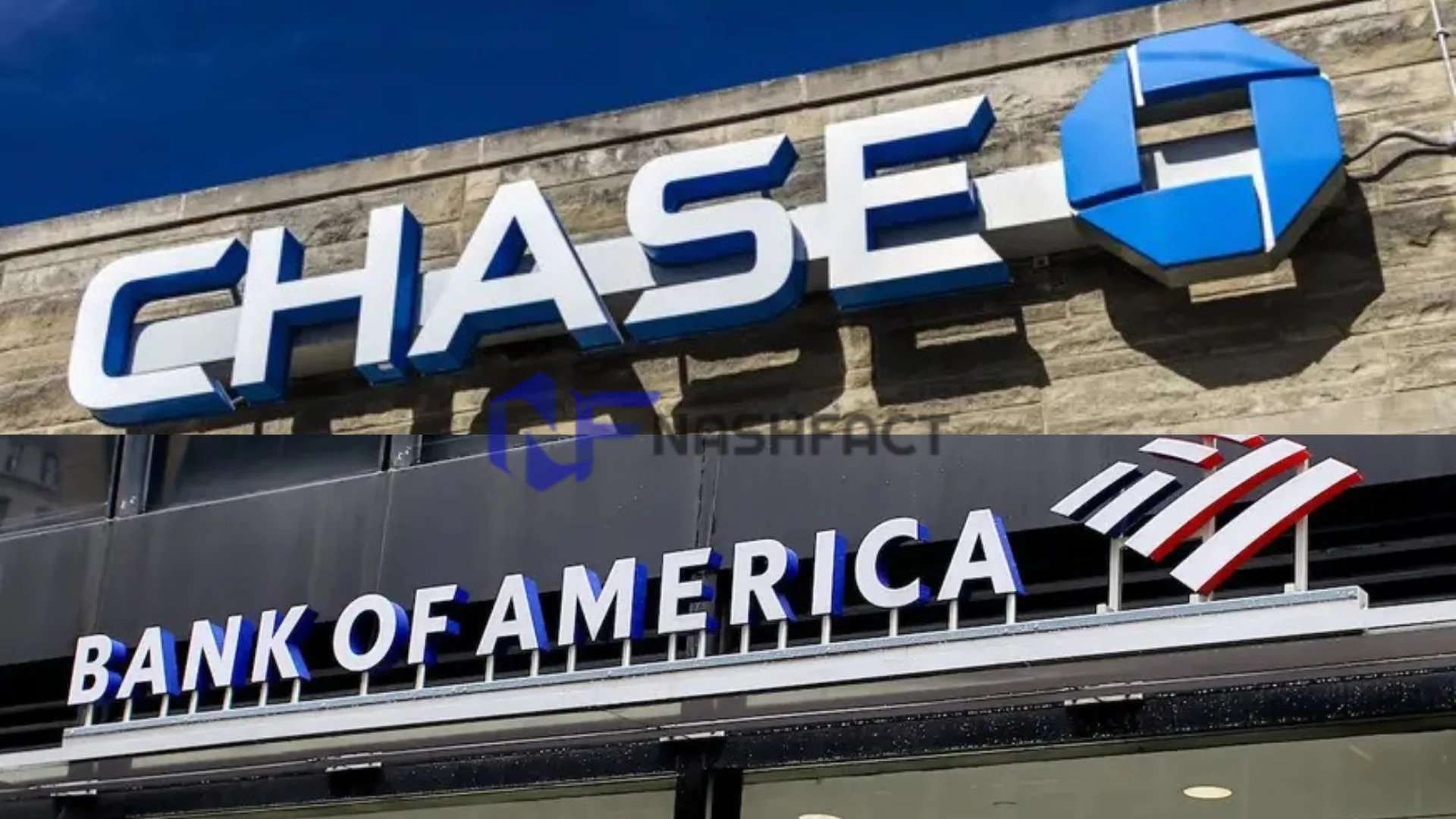- 27 September 2023
- No Comment
- 824
Comparing JPMorgan Chase and Bank of America: Choosing the Right Bank for Your Needs

I’m Nabeel, a seasoned Chartered Accountant with a remarkable 17-year journey through the worlds of investment banking, management consulting, and entrepreneurship. In the realm of retail banking, both JPMorgan Chase and Bank of America are formidable players, each offering a plethora of financial solutions. However, making the right choice between these two giants necessitates a thorough evaluation and comparison of your specific financial needs and preferences.
JPMorgan Chase: A Giant in Convenience
Overview of JPMorgan Chase JPMorgan Chase reigns as the largest bank in the United States, boasting a nationwide presence with over 4,800 branches and approximately 16,000 ATMs across 48 states and the District of Columbia. If convenience is your primary concern, JPMorgan Chase undoubtedly offers an extensive network for your banking needs.
Interest Rates and Account Options Despite its vast reach, JPMorgan Chase’s interest rates might not impress the discerning saver. Nevertheless, the bank caters to a diverse clientele by providing a range of banking options. Its two fundamental savings accounts, namely Chase Savings and Chase Premier Savings, cater to customers with varying balances. The latter offers slightly better rates and benefits, primarily targeting those with higher balances. However, it’s worth noting that many fee waivers at Chase hinge on maintaining specific account minimums, which may not be suitable for everyone, especially those starting with modest balances.
Bank of America: A Global Perspective 
Bank of America’s Expansive Reach Bank of America, with its roots dating back to 1904 as the Bank of Italy, has grown into a global financial institution. Beyond traditional banking, it offers services such as home loans, auto loans, and investment opportunities through Merrill Lynch. With approximately 3,900 branches and a substantial ATM network, Bank of America ensures accessibility across the nation.
Interest Rates and Mobile Banking While Bank of America is among the country’s largest banks, its interest rates may not top the charts. However, if you prioritize features beyond incremental savings, Bank of America has much to offer.
Notably, it excels in the realm of mobile banking with robust Apple and Android apps that empower users to manage their accounts efficiently. Features include reviewing account activity, ordering checks, initiating mobile bill payments, executing internal and external transfers via Zelle, locating nearby ATMs and branches, setting up secure login procedures, and more.
Comparing Account Offerings: JPMorgan Chase and Bank of America
When deciding between JPMorgan Chase and Bank of America, a comprehensive comparison of their bank accounts is pivotal. Both banks extend a range of options, allowing customers to consolidate their financial services under one roof.
JPMorgan Chase’s Account Portfolio
Types of Savings and Checking Accounts JPMorgan Chase presents customers with the choice of two savings accounts,
- Chase Savings
- Chase Premier Savings Accounts
Additionally, it offers an array of checking accounts, including:
- Total Checking
- Premier Plus Checking
- Secure Banking
- First Banking
- High School Checking
- College Checking
- Sapphire Checking
- and Private Client Checking
The bank also provides various certificates of deposit (CDs) with term lengths spanning from one month to a decade.
Bank of America’s Diverse Account Selection
Bank of America’s Array of Accounts Bank of America tailors its account offerings to meet the diverse needs of its customers. This includes multiple savings accounts, with the Rewards Savings Account standing out for its benefits linked to spending patterns. The bank also features two types of CDs, each requiring a minimum initial deposit of $1,000, and offers tax-advantaged plans such as traditional and Roth IRAs.
Tax-Advantaged Plans
Tax-advantaged plans are financial accounts or investments that offer tax benefits to individuals. These plans are designed to encourage saving and investing for specific financial goals, such as retirement, education, or healthcare expenses. The tax advantages typically include tax deductions, tax-deferred growth, or tax-free withdrawals, depending on the type of plan. Common tax-advantaged plans include retirement accounts like Traditional and Roth IRAs, employer-sponsored 401(k) plans, 529 college savings plans, and Health Savings Accounts (HSAs).
Traditional IRA (Individual Retirement Account)
A Traditional IRA is a retirement savings account in which individuals can contribute pre-tax dollars, reducing their taxable income for the year of contribution. The investments within the IRA grow tax-deferred until retirement. Withdrawals from a Traditional IRA are typically subject to income tax, and there may be penalties for early withdrawals before age 59½. Traditional IRAs are often used to reduce current tax liability while saving for retirement, and they are suitable for individuals who expect to be in a lower tax bracket during retirement.
Roth IRA (Individual Retirement Account)
A Roth IRA is another type of retirement savings account, but it operates differently from a Traditional IRA. Contributions to a Roth IRA are made with after-tax dollars, so there is no immediate tax deduction. However, the key benefit of a Roth IRA is that qualified withdrawals, including both contributions and earnings, are tax-free in retirement. Additionally, Roth IRAs do not have mandatory minimum distribution requirements, making them a flexible option for retirement savings. Roth IRAs are suitable for individuals who anticipate being in a similar or higher tax bracket during retirement and want to enjoy tax-free income in retirement.
Analyzing Fees and Costs
In the realm of fees and costs, understanding the nuances of JPMorgan Chase and Bank of America’s offerings is essential to making an informed choice.
JPMorgan Chase
| Account Types | Charges | Additional Information |
| Chase Secure Banking | Monthly Service Fee: $4.95 | No minimum deposit required. Limited services. |
| Chase Total Checking® | Monthly Service Fee: $12 | Waivable: $500+ electronic deposits, $1,500+ daily balance, $5,000+ average beginning day balance. Overdraft services available. Fees for wire transfers and money orders. |
| Chase Premier Plus | Monthly Service Fee: $25 | Waivable: $15,000+ combined daily balance, linked qualifying mortgage, or valid military ID. No additional ATM fees, and certain fees are waived for military members. 0.01% interest rate. No fee for select checks. |
| Chase Sapphire Checking | Monthly Service Fee: $25 | Waivable: $75,000+ combined daily minimum balance across linked accounts. No fees for various services, including wire transfers. No insufficient funds fee within the first four business days. 0.01% interest rate. |
| Chase Private Client Checking | Monthly Service Fee: $35 | Waivable: $150,000+ combined daily balance, linked Chase Platinum Business Checking, or valid military ID. No fees for various services, including wire transfers. No insufficient funds fee within the first four business days. 0.01% interest rate. |
| Chase Savings | Monthly Service Fee: $5 | Waivable conditions: Linked to qualifying checking account, $300+ minimum daily balance, $25+ automatic monthly transfer, linked Chase College Checking account for overdraft protection, or under 18 years old. $5 Savings Withdrawal Limit Fee. |
| Chase Premier Savings | Monthly Maintenance Fee: $25 | Waivable: $15,000+ daily balance or linked checking account. $5 fee per withdrawal if more than six per month. Certain fees waived. |
| Chase Private Client Savings | No Monthly Service Fee | Requires a Chase Private Client Checking account. No fees for various services. Variable interest rate. |
| Chase Overdraft fees | Overdraft Fee: $34 per item | $0 to $50 for wire transfers. No fee for checks ordered through Chase. |
| Chase ATM fees | Non-Chase ATM in the U.S.: $3 per transaction | International ATM fees: $5 per withdrawal (plus any ATM owner charges). ATM withdrawal limits vary. |
| Penalties and withdrawal fees | Savings Withdrawal Limit Fee: $5 per withdrawal over six per month | Maximum three fees per month, up to $15. Applies to all withdrawal and transfer transactions. |
| Other fees | Stop Payment: $30 per request, Online or Automated Phone Stop Payment: $25 per request | Deposited Item Returned or Cashed Check Returned: $12 per item. Various fees for checks, money orders, legal processing, etc. |
Please note that fees and conditions may change over time, so it’s advisable to verify the latest fee schedules with Chase Bank for the most up-to-date information.
Bank of America
| Account Types | Charges | Additional Information |
| Advantage SafeBalance Banking® | Monthly Maintenance Fee: $4.95 | Waived for students under 25, individuals under 18, or Preferred Rewards® Program enrollment. Limited services, no personal checks.2 |
| Advantage Plus Banking® | Monthly Maintenance Fee: $12 | Waivable with qualifying Direct Deposit, $1,500+ daily balance, or Preferred Rewards® Program enrollment. Minimum daily balance required.3 |
| Advantage Relationship Banking® | Monthly Maintenance Fee: $25 | Waivable with $10,000+ combined balances or Preferred Rewards® Program enrollment. Multiple linked accounts.4 |
| Advantage Savings | Monthly Maintenance Fee: $8 (waived for six months for new accounts) | Waived with $500+ daily balance, linked Advantage Relationship Banking, Preferred Rewards, under 18, or qualifying student status.1 |
| Overdraft Fees | Overdraft Fee: $10 for the first two overdrawn items per day over $1 | Preferred Rewards Diamond tier members eligible for fee waiver.5 |
| Copies of Documents Fees | Check and Deposit Copy Fee: $3 per copy (first two copies free, up to $75 max) | Paper Statement Copy Fee: $5 (Preferred Rewards and Advantage Relationship Banking waivers).5 |
| ATM Transaction Fees | Non-Bank of America ATM in the U.S.: $2.50 per transaction | International ATM Withdrawal: $5 + 3% International Transaction Fee (plus issuer fees).5 |
| Check Fees | Check Cashing Fee (for non-account holders): $8 for checks over $50 | Waived for Bank of America account holders.5 |
| Wire Transfer Fees | Incoming Domestic: $15 per transaction | Incoming Foreign: $16 per transaction. Outgoing Domestic: $30 per transaction. Outgoing Foreign (in USD): $45 per transaction. Waivers apply for certain accounts.5 |
| Card Replacement Fees | Debit Card Replacement: $5 (additional $15 rush fee for urgent requests) | Waivers for Preferred Rewards and Advantage Relationship Banking accounts. Fee not charged for cards replaced upon expiration.5 |
Please note that fees and conditions may change over time, so it’s advisable to verify the latest fee schedules with Bank of America for the most up-to-date information.
Evaluating Interest Rates
In a world where interest rates matter, a critical analysis of JPMorgan Chase and Bank of America’s offerings is essential to assess your potential earnings.
Interest Rate Comparison
JPMorgan Chase Rates
Unfortunately, when it comes to interest rates, JPMorgan Chase and Bank of America can’t compete with online banks and credit unions. JPMorgan Chase’s base rate sits at the lowest end, offering a mere 0.01% APY*. A slightly higher rate of 0.02% can be achieved by linking a Chase Premier Savings account to a Chase checking account and maintaining a balance of at least $250,000. Chase’s CDs feature annual percentage yields ranging from 0.01% to 5.00%, contingent on balance and term.
Bank of America’s Rates
Bank of America’s basic checking account offers rates ranging from 0.01% to 0.02%, contingent on qualified account activity. Its basic savings account echoes the same 0.01% rate, also linked to qualified account activity. Meanwhile, Bank of America’s money market accounts offer a spectrum of rates, ranging from 0.03% to 0.6%, depending on the term and balance. CD interest rates span from 0.03% to 5.00%.
Please note that fees and conditions may change over time, so it’s essential to verify the latest fee schedules from the respective banks before making any financial decisions.
*APY, or Annual Percentage Yield, is a financial metric used to calculate the total amount of interest earned or paid on a savings account or investment over the course of one year. A higher APY indicates that your money will grow or cost you more over time compared to an account with a lower APY. It’s a crucial factor to consider when assessing the profitability or cost-effectiveness of various financial products.
Comparing CD Rates: JPMorgan Chase and Bank of America
Bank of America CD Rates
Term Lengths: Bank of America provides CD options ranging from as short as 28 days to as long as 10 years.
Minimum Opening Deposit: To open a Bank of America CD account, a minimum deposit of $1,000 is required.
APY (Annual Percentage Yield): Bank of America’s CD rates vary by location and term length. Notably, the bank offers relatively higher rates for 3-month, 4-month, and 5-month terms. Additionally, there is a Bank of America Featured CD, which provides APY ranging from 0.05% to 4.70% (varies by location) and is available for 7-month, 10-month, 13-month, 25-month, and 37-month CDs. Moreover, the Bank of America Flexible CD offers a competitive rate without imposing early withdrawal penalties.
Chase CD Rates
Term Lengths: Chase offers CD terms ranging from 1 month to 10 years.
Minimum Opening Deposit: A minimum deposit of $1,000 is required to open a Chase CD account.
APY: Chase’s CD rates are location-dependent and vary across different regions. The bank offers more competitive rates for shorter-term CDs, particularly for 3-month, 6-month, and 12-month terms.
Early Withdrawal Penalties: Both banks have early withdrawal penalties, with the specific penalties varying depending on the term length.
Bank of America stands out for higher rates on certain short-term CD options and offers specialized CDs like the Featured and Flexible CD, Chase tends to be more competitive for shorter-term CDs. When considering CD options, it’s important to factor in your location and individual financial goals.
Trustworthiness: JPMorgan Chase and Bank of America
Determining which bank is more trustworthy is not a straightforward task. Both JPMorgan Chase & Co. (the parent company of Chase) and Bank of America have received favorable ratings from the Better Business Bureau (BBB), with JPMorgan Chase earning an A+ rating and Bank of America an A- rating.
However, despite their positive BBB ratings, both banks have faced their fair share of public controversies in recent years. Here are some notable instances involving Chase:
Chase’s Controversies:
- In 2020, JP Morgan Chase & Co. reached a $920 million settlement with the Department of Justice over allegations of wrongful trading practices.
- During the same year, the US Department of Labor mandated that Chase pay $800,000 in back wages as part of a settlement related to accusations of gender-based wage disparities.
Similarly, Bank of America has experienced its own challenges:
Bank of America’s Issues:
- In 2022, the Consumer Financial Protection Bureau (CFPB) imposed fines on Bank of America for freezing customers’ accounts due to inaccuracies in its automatic fraud detection system. Customers encountered difficulties in unfreezing their accounts.
- In 2020, the Department of Justice charged Bank of America for allegedly denying home loans to qualified adults with disabilities. The bank settled the case by providing compensation, totaling approximately $300,000, to individuals who had been denied loans.
In summary, while BBB ratings provide a positive outlook for both banks, it’s essential to consider their individual histories of public disputes and settlements when assessing their overall trustworthiness.
The Verdict: JPMorgan Chase and Bank of America
As an investment banker, my recommendation after a thorough comparison of JPMorgan Chase and Bank of America is as follows:
Key Differences:
- Account Variety: JPMorgan Chase offers a wider range of account options, making it suitable for a diverse clientele, while Bank of America focuses on streamlined account offerings.
- IRA Options: Bank of America stands out with its traditional and Roth IRA options, providing valuable retirement savings choices.
- Branch Networks: JPMorgan Chase boasts a larger branch network, which may be advantageous for customers who prefer in-person banking.
Benefits:
JPMorgan Chase
Ideal for customers seeking diverse account choices and those who value branch accessibility. The bank’s website and mobile interfaces are user-friendly and packed with convenient features.
Bank of America
A strong choice for individuals interested in traditional and Roth IRAs, as well as those who prioritize mobile banking convenience and easy access to accounts.
Ultimately, the best choice between these two banks should align with your specific financial needs and preferences. Both institutions offer extensive branch networks and ATMs, but the suitability of their account options, fees, and interest rates will hinge on your individual financial goals and lifestyle.
Your decision should be a thoughtful one, crafted to fit your distinct circumstances and financial goals. Keep in mind that fees and conditions can change over time, so it’s crucial to verify the latest fee schedules from both banks before making any financial decisions. Your choice should empower you to manage your finances effectively and achieve your investment objectives.


